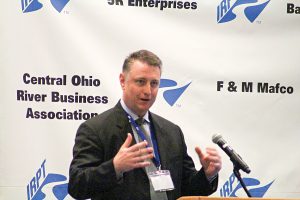Natural Infrastructure Initiative Examined At IRPT
Don McNeill, strategic growth manager for Caterpillar Inc.’s Earthmoving Division and the director of the Natural Infrastructure Initiative (NII), presented an overview of NII and Caterpillar’s role in restoring and advancing natural infrastructure at the annual conference of Inland Rivers, Ports & Terminals in Cincinnati, Ohio, April 25.
In his overview, McNeill related the initiative to the inland marine transportation industry by way of dredged sediment and potential beneficial usage of it. As of now, the Army Corps of Engineers dredges sediment from many river systems and in many cases where it is not beneficially reused, stores it on land near the rivers in Dredged Materials Management Areas (DMMA), he said.

The initiative was established following the Restoring Natural Infrastructure Summit in New York City in 2015, where 150 participants representing Caterpillar, its dealers, its customers, NGOs, federal agencies and other private companies convened. During this summit, the need for a coalition to help drive changes needed to restore and develop natural infrastructure was identified.
In 2016, McNeill said Caterpillar met with various companies to discuss creating a natural infrastructure coalition. Shortly thereafter, the company conducted an internal study of the natural infrastructure industry, which focuses in part on forests, prairies, agricultural lands, estuaries, coastal landscapes and wetlands.
According to Caterpillar, healthy natural infrastructure offers many economic, environmental and social benefits—including productive fisheries along our coasts, increased biodiversity, improved storm resilience, recreation and tourism opportunities, improved water quality and enhanced scenic beauty.
Caterpillar’s NII was officially rolled out early last year and now has a total of six members. In addition to Caterpillar, the member organizations are The Nature Conservancy, AECOM, Great Lakes Dredge & Dock, Brown & Root and Intrexon.
Beneficial Use Of Dredged Sediment
While addressing attendees, McNeill said he presented his information as a way of challenging the inland marine transportation industry. “I wanted to know how we use—and can productively reuse—the amount of material that is dredged annually from our rivers,” he said.
The U.S. Army Corps of Engineers manages approximately 12,000 miles of shallow-draft waterways from 9 to 14 feet; 13,000 miles of deep-draft waterways from more than 14 feet; and at least 400 ports, harbors and turning stations. McNeill acknowledged that these programs, in conjunction with non-Corps dredging programs, puts annual dredging at approximately 200 million cubic yards of sediment. Of that, only an estimated 50 million cubic yards is beneficially reused.
“This means that at least 150 million cubic yards of that isn’t used in a beneficial way, such as in wetland restorations, beach nourishment, storm and flood protection or in engineered soil,” he added.
While McNeill acknowledged that not everyone has the same opportunity to use dredged sediment in a way that builds or improves natural infrastructure depending on where they are located, it is important to consider how such materials can be used in future projects. “How can natural infrastructure and potentially using dredged material be a piece or a larger piece of a project? Can it help the project to be completed more economically or help to produce multiple benefits?” asked McNeill. “Are there new ideas, concepts or opportunities for which beneficial reuse of dredged material can take shape?”
To help put words into action, McNeill said NII is collaborating with the Corps and non-federal stakeholders, to find beneficial uses of dredged sediment close to dredging projects. The most frequent beneficial uses help to develop natural infrastructure, such as beach nourishment and wetland restoration, but McNeill said people need to get more creative to reuse higher volumes. In that light, he referenced the concept of engineered soil, and admits that although there are very few projects of this type today, the possibilities are endless.
“I really challenge us to think about that 150 million cubic yards of material that isn’t being reused,” he said. “As nature will continue to deposit sediment in the river systems, this challenge will continue to exist.”
In one specific example, McNeill referenced a site where the Corps has a 40-year future dredge plan, which means the area it dredges has to be maintained to pre-determined depths. He said this produces roughly 50,000 additional cubic yards of sediment per year.
Currently, the Corps uses a DMMA at that site that is near capacity. McNeill said that as the DMMA continues to fill up, the Corps will have to look at other options for placing the dredged sediment. “The Corps would be looking, most times, at a primary option of acquiring more land to store more sand,” he said. “They have about 50 acres right now, and they could need up to 130 additional acres to store the next 40 years’ worth of sand. Today, some of that land is productive farm land that a farmer may or may not want to sell. What if you could use all that sediment just sitting there as a part of a business model that not only sustainably consumes what is produced, but puts it to use and potentially reclaims some of the land that is being taken up by millions of cubic yards of stockpiled material?”
As for why Caterpillar decided to get involved in developing NII and looking at other uses for dredged material, McNeill said the answer is simple. “We know about infrastructure; that’s our business,” he said. “Our customers use our equipment to build traditional and natural infrastructure. We see the opportunity exists for increasing uses of natural infrastructure to address the nation’s infrastructure challenges. We provide solutions that serve all types of infrastructure and help our customers build a better world.”



